BMRK231 Marketing Term Paper: Distribution Strategies in Fast Food
VerifiedAdded on 2022/08/20
|9
|1822
|37
Report
AI Summary
This report provides a comprehensive overview of distribution strategies within the fast-food industry, a key element of the marketing mix. It explores various strategies, including direct, indirect, intensive, selective, and exclusive distribution, and their significance in making products and services accessible to consumers. The paper examines how these strategies are employed by major fast-food companies to enhance customer reach and sales. The report delves into the distribution channels prevalent in the industry, such as food suppliers, advertisements, promotions, and internet marketing. Furthermore, the report uses case studies of prominent fast-food companies, including McDonald's, KFC, Starbucks, and Pizza Hut, to illustrate how each company tailors its distribution strategies to meet customer needs and achieve market success. The analysis highlights the impact of distribution strategies on customer attraction and profitability, as well as the importance of adapting strategies based on customer preferences and market dynamics.
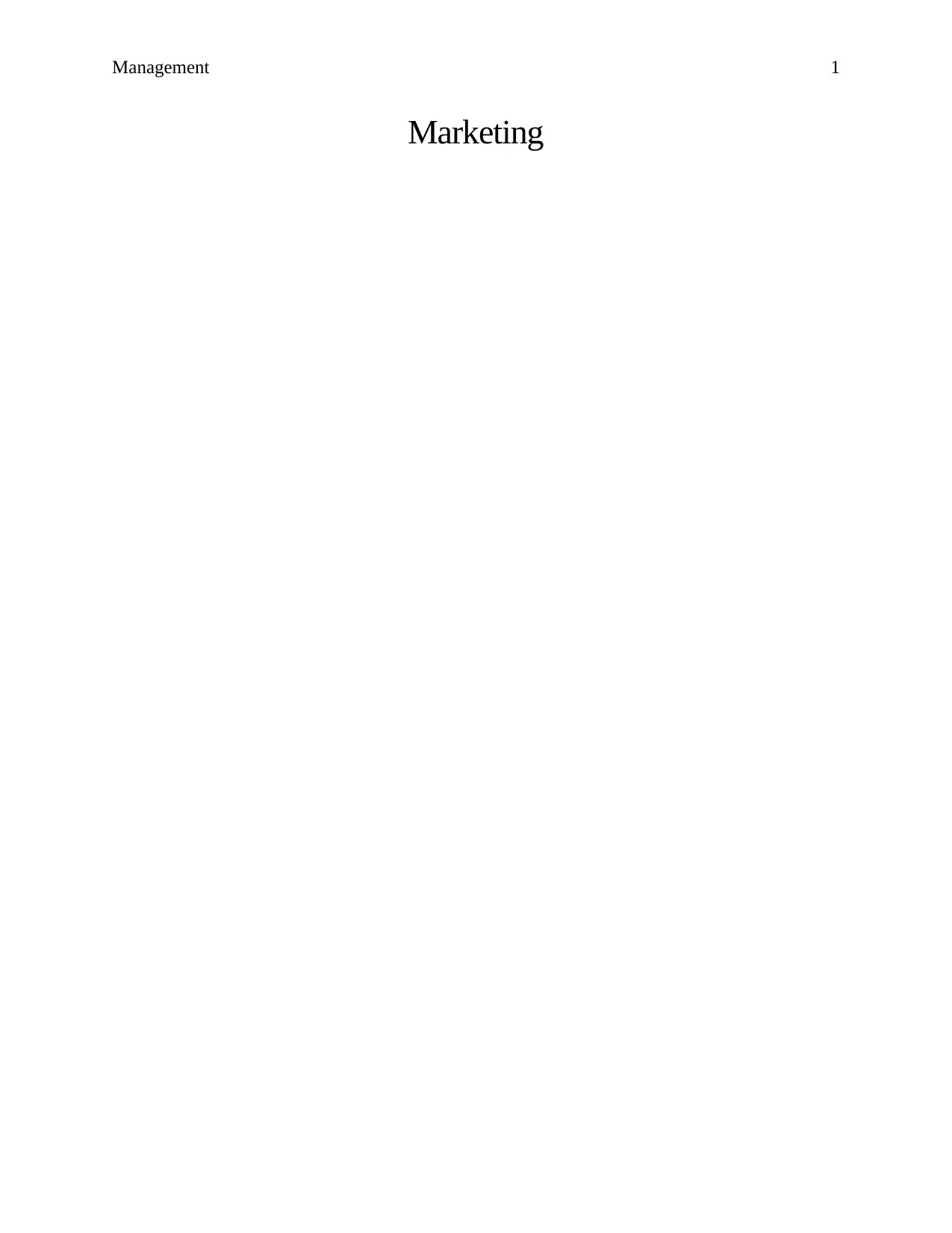
Management 1
Marketing
Marketing
Paraphrase This Document
Need a fresh take? Get an instant paraphrase of this document with our AI Paraphraser

Management 2
Contents
Introduction......................................................................................................................................3
Distribution Strategies used in Fast food industry...........................................................................4
Examples of companies related to the strategies.............................................................................6
Conclusion.......................................................................................................................................8
References........................................................................................................................................9
Contents
Introduction......................................................................................................................................3
Distribution Strategies used in Fast food industry...........................................................................4
Examples of companies related to the strategies.............................................................................6
Conclusion.......................................................................................................................................8
References........................................................................................................................................9
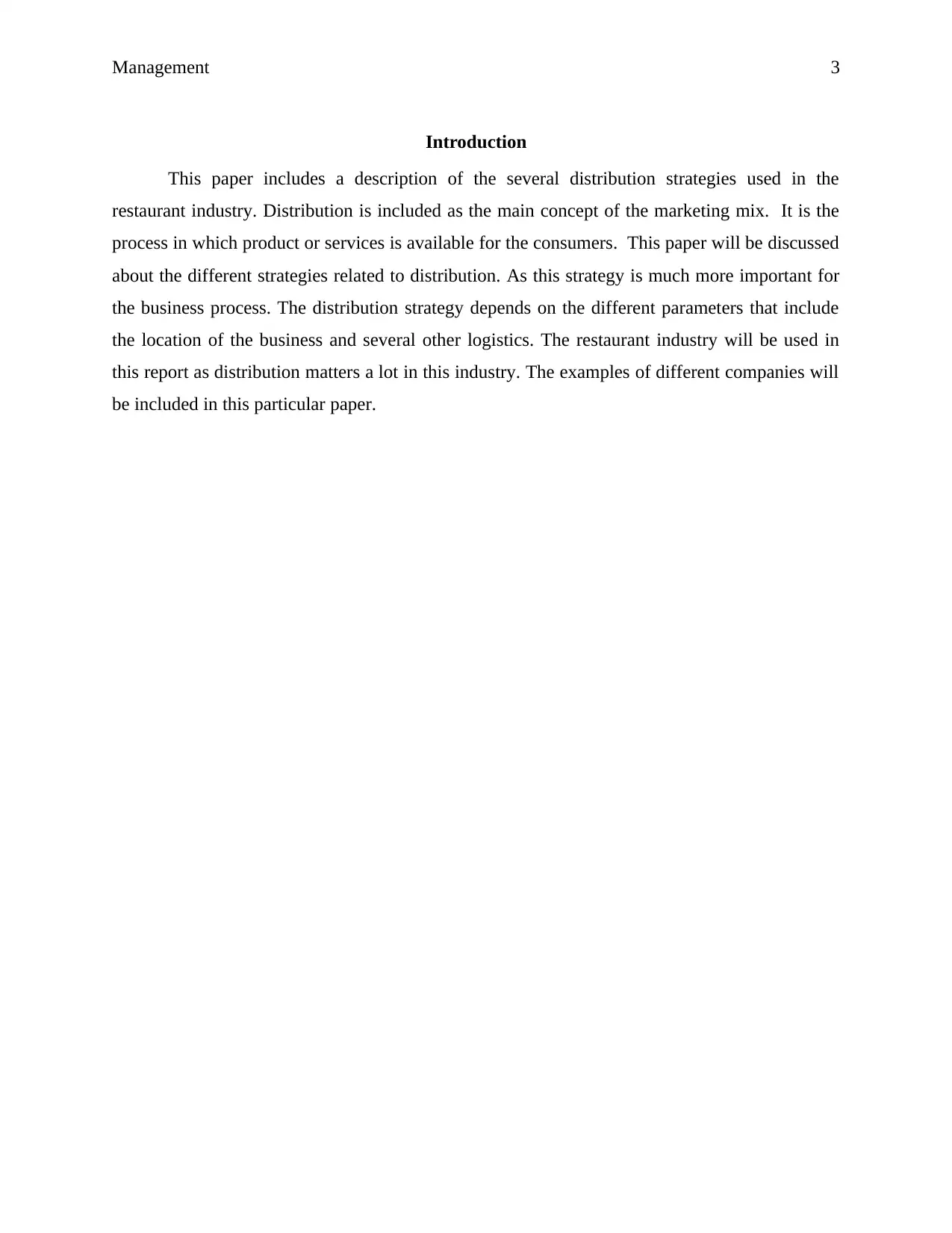
Management 3
Introduction
This paper includes a description of the several distribution strategies used in the
restaurant industry. Distribution is included as the main concept of the marketing mix. It is the
process in which product or services is available for the consumers. This paper will be discussed
about the different strategies related to distribution. As this strategy is much more important for
the business process. The distribution strategy depends on the different parameters that include
the location of the business and several other logistics. The restaurant industry will be used in
this report as distribution matters a lot in this industry. The examples of different companies will
be included in this particular paper.
Introduction
This paper includes a description of the several distribution strategies used in the
restaurant industry. Distribution is included as the main concept of the marketing mix. It is the
process in which product or services is available for the consumers. This paper will be discussed
about the different strategies related to distribution. As this strategy is much more important for
the business process. The distribution strategy depends on the different parameters that include
the location of the business and several other logistics. The restaurant industry will be used in
this report as distribution matters a lot in this industry. The examples of different companies will
be included in this particular paper.
⊘ This is a preview!⊘
Do you want full access?
Subscribe today to unlock all pages.

Trusted by 1+ million students worldwide
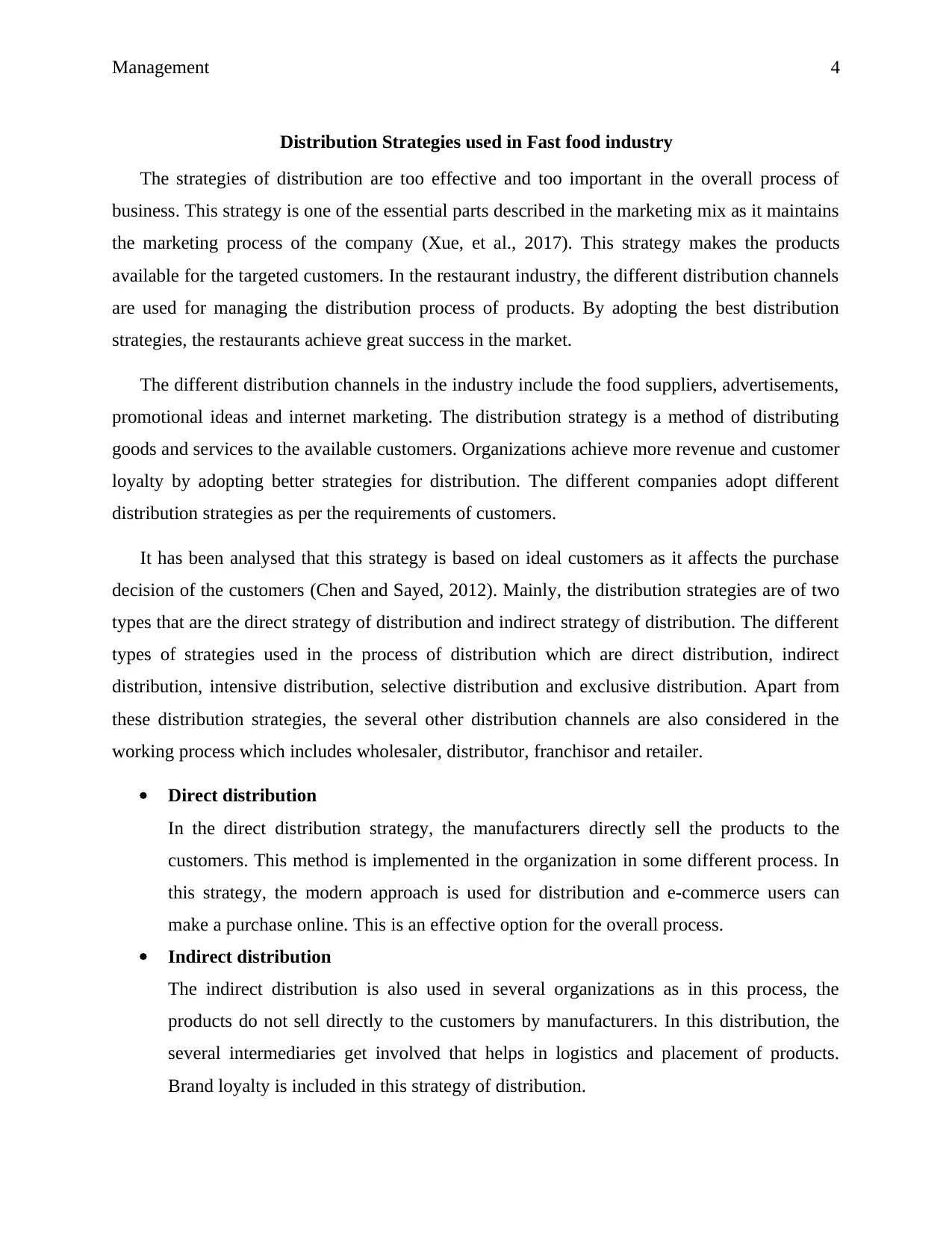
Management 4
Distribution Strategies used in Fast food industry
The strategies of distribution are too effective and too important in the overall process of
business. This strategy is one of the essential parts described in the marketing mix as it maintains
the marketing process of the company (Xue, et al., 2017). This strategy makes the products
available for the targeted customers. In the restaurant industry, the different distribution channels
are used for managing the distribution process of products. By adopting the best distribution
strategies, the restaurants achieve great success in the market.
The different distribution channels in the industry include the food suppliers, advertisements,
promotional ideas and internet marketing. The distribution strategy is a method of distributing
goods and services to the available customers. Organizations achieve more revenue and customer
loyalty by adopting better strategies for distribution. The different companies adopt different
distribution strategies as per the requirements of customers.
It has been analysed that this strategy is based on ideal customers as it affects the purchase
decision of the customers (Chen and Sayed, 2012). Mainly, the distribution strategies are of two
types that are the direct strategy of distribution and indirect strategy of distribution. The different
types of strategies used in the process of distribution which are direct distribution, indirect
distribution, intensive distribution, selective distribution and exclusive distribution. Apart from
these distribution strategies, the several other distribution channels are also considered in the
working process which includes wholesaler, distributor, franchisor and retailer.
Direct distribution
In the direct distribution strategy, the manufacturers directly sell the products to the
customers. This method is implemented in the organization in some different process. In
this strategy, the modern approach is used for distribution and e-commerce users can
make a purchase online. This is an effective option for the overall process.
Indirect distribution
The indirect distribution is also used in several organizations as in this process, the
products do not sell directly to the customers by manufacturers. In this distribution, the
several intermediaries get involved that helps in logistics and placement of products.
Brand loyalty is included in this strategy of distribution.
Distribution Strategies used in Fast food industry
The strategies of distribution are too effective and too important in the overall process of
business. This strategy is one of the essential parts described in the marketing mix as it maintains
the marketing process of the company (Xue, et al., 2017). This strategy makes the products
available for the targeted customers. In the restaurant industry, the different distribution channels
are used for managing the distribution process of products. By adopting the best distribution
strategies, the restaurants achieve great success in the market.
The different distribution channels in the industry include the food suppliers, advertisements,
promotional ideas and internet marketing. The distribution strategy is a method of distributing
goods and services to the available customers. Organizations achieve more revenue and customer
loyalty by adopting better strategies for distribution. The different companies adopt different
distribution strategies as per the requirements of customers.
It has been analysed that this strategy is based on ideal customers as it affects the purchase
decision of the customers (Chen and Sayed, 2012). Mainly, the distribution strategies are of two
types that are the direct strategy of distribution and indirect strategy of distribution. The different
types of strategies used in the process of distribution which are direct distribution, indirect
distribution, intensive distribution, selective distribution and exclusive distribution. Apart from
these distribution strategies, the several other distribution channels are also considered in the
working process which includes wholesaler, distributor, franchisor and retailer.
Direct distribution
In the direct distribution strategy, the manufacturers directly sell the products to the
customers. This method is implemented in the organization in some different process. In
this strategy, the modern approach is used for distribution and e-commerce users can
make a purchase online. This is an effective option for the overall process.
Indirect distribution
The indirect distribution is also used in several organizations as in this process, the
products do not sell directly to the customers by manufacturers. In this distribution, the
several intermediaries get involved that helps in logistics and placement of products.
Brand loyalty is included in this strategy of distribution.
Paraphrase This Document
Need a fresh take? Get an instant paraphrase of this document with our AI Paraphraser
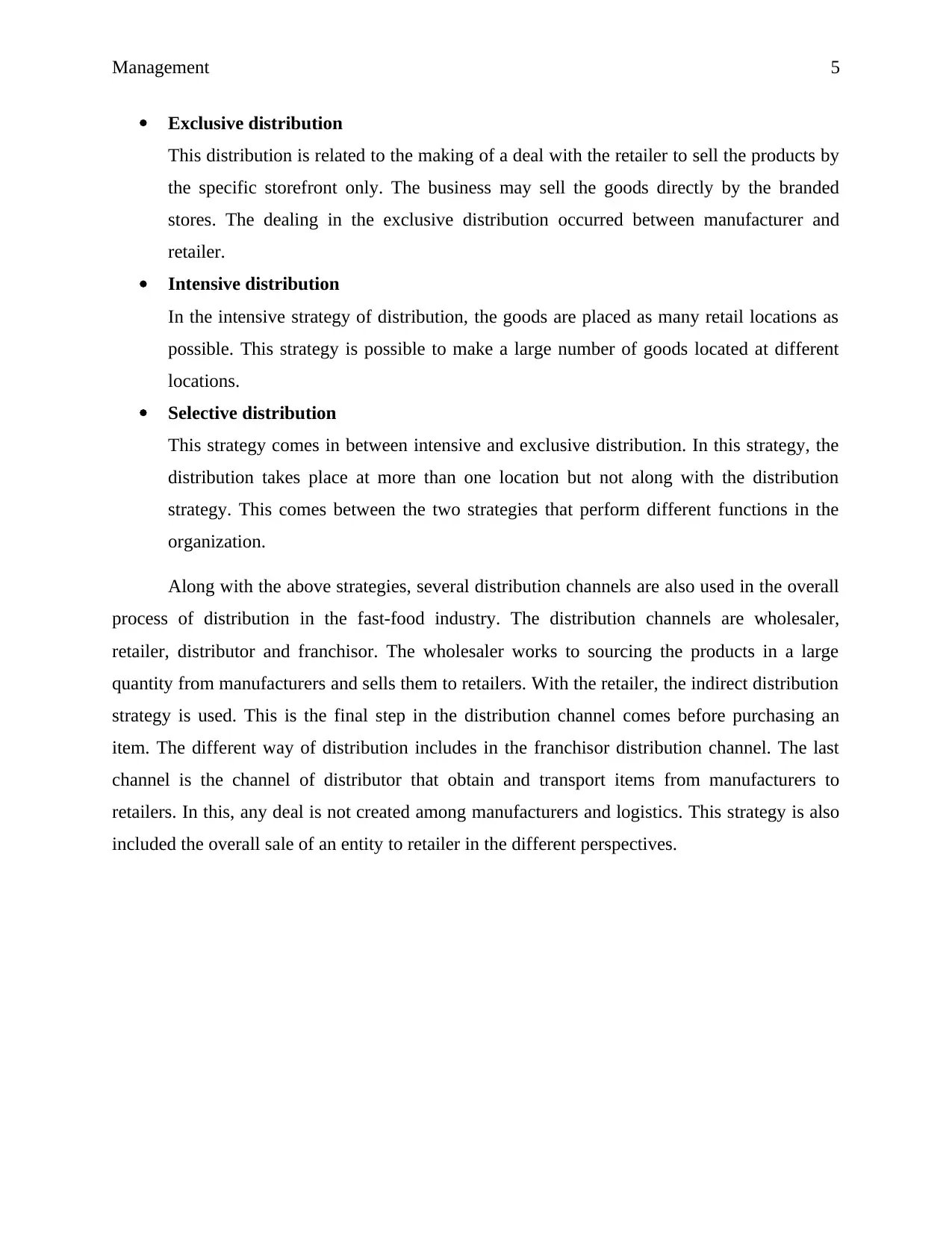
Management 5
Exclusive distribution
This distribution is related to the making of a deal with the retailer to sell the products by
the specific storefront only. The business may sell the goods directly by the branded
stores. The dealing in the exclusive distribution occurred between manufacturer and
retailer.
Intensive distribution
In the intensive strategy of distribution, the goods are placed as many retail locations as
possible. This strategy is possible to make a large number of goods located at different
locations.
Selective distribution
This strategy comes in between intensive and exclusive distribution. In this strategy, the
distribution takes place at more than one location but not along with the distribution
strategy. This comes between the two strategies that perform different functions in the
organization.
Along with the above strategies, several distribution channels are also used in the overall
process of distribution in the fast-food industry. The distribution channels are wholesaler,
retailer, distributor and franchisor. The wholesaler works to sourcing the products in a large
quantity from manufacturers and sells them to retailers. With the retailer, the indirect distribution
strategy is used. This is the final step in the distribution channel comes before purchasing an
item. The different way of distribution includes in the franchisor distribution channel. The last
channel is the channel of distributor that obtain and transport items from manufacturers to
retailers. In this, any deal is not created among manufacturers and logistics. This strategy is also
included the overall sale of an entity to retailer in the different perspectives.
Exclusive distribution
This distribution is related to the making of a deal with the retailer to sell the products by
the specific storefront only. The business may sell the goods directly by the branded
stores. The dealing in the exclusive distribution occurred between manufacturer and
retailer.
Intensive distribution
In the intensive strategy of distribution, the goods are placed as many retail locations as
possible. This strategy is possible to make a large number of goods located at different
locations.
Selective distribution
This strategy comes in between intensive and exclusive distribution. In this strategy, the
distribution takes place at more than one location but not along with the distribution
strategy. This comes between the two strategies that perform different functions in the
organization.
Along with the above strategies, several distribution channels are also used in the overall
process of distribution in the fast-food industry. The distribution channels are wholesaler,
retailer, distributor and franchisor. The wholesaler works to sourcing the products in a large
quantity from manufacturers and sells them to retailers. With the retailer, the indirect distribution
strategy is used. This is the final step in the distribution channel comes before purchasing an
item. The different way of distribution includes in the franchisor distribution channel. The last
channel is the channel of distributor that obtain and transport items from manufacturers to
retailers. In this, any deal is not created among manufacturers and logistics. This strategy is also
included the overall sale of an entity to retailer in the different perspectives.
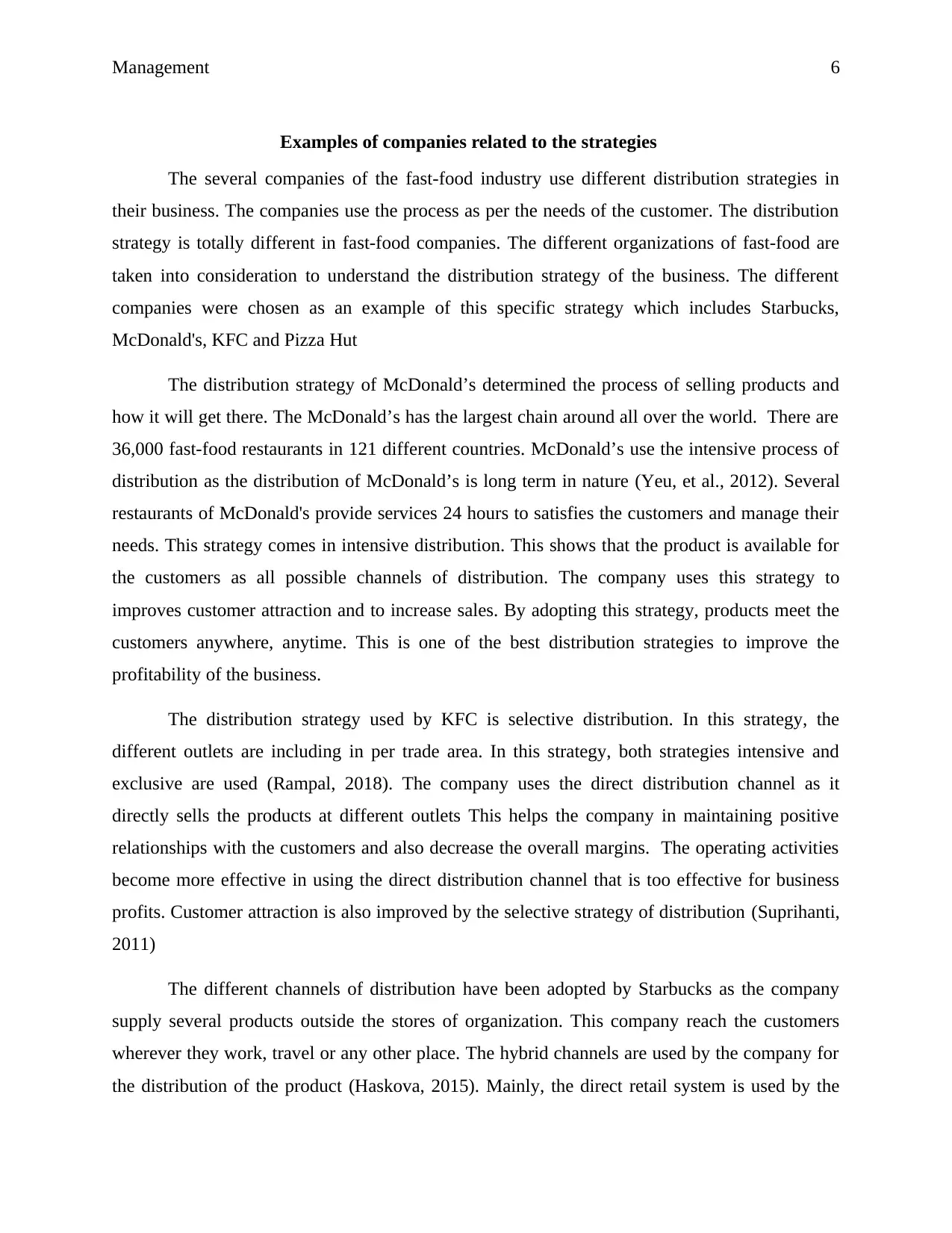
Management 6
Examples of companies related to the strategies
The several companies of the fast-food industry use different distribution strategies in
their business. The companies use the process as per the needs of the customer. The distribution
strategy is totally different in fast-food companies. The different organizations of fast-food are
taken into consideration to understand the distribution strategy of the business. The different
companies were chosen as an example of this specific strategy which includes Starbucks,
McDonald's, KFC and Pizza Hut
The distribution strategy of McDonald’s determined the process of selling products and
how it will get there. The McDonald’s has the largest chain around all over the world. There are
36,000 fast-food restaurants in 121 different countries. McDonald’s use the intensive process of
distribution as the distribution of McDonald’s is long term in nature (Yeu, et al., 2012). Several
restaurants of McDonald's provide services 24 hours to satisfies the customers and manage their
needs. This strategy comes in intensive distribution. This shows that the product is available for
the customers as all possible channels of distribution. The company uses this strategy to
improves customer attraction and to increase sales. By adopting this strategy, products meet the
customers anywhere, anytime. This is one of the best distribution strategies to improve the
profitability of the business.
The distribution strategy used by KFC is selective distribution. In this strategy, the
different outlets are including in per trade area. In this strategy, both strategies intensive and
exclusive are used (Rampal, 2018). The company uses the direct distribution channel as it
directly sells the products at different outlets This helps the company in maintaining positive
relationships with the customers and also decrease the overall margins. The operating activities
become more effective in using the direct distribution channel that is too effective for business
profits. Customer attraction is also improved by the selective strategy of distribution (Suprihanti,
2011)
The different channels of distribution have been adopted by Starbucks as the company
supply several products outside the stores of organization. This company reach the customers
wherever they work, travel or any other place. The hybrid channels are used by the company for
the distribution of the product (Haskova, 2015). Mainly, the direct retail system is used by the
Examples of companies related to the strategies
The several companies of the fast-food industry use different distribution strategies in
their business. The companies use the process as per the needs of the customer. The distribution
strategy is totally different in fast-food companies. The different organizations of fast-food are
taken into consideration to understand the distribution strategy of the business. The different
companies were chosen as an example of this specific strategy which includes Starbucks,
McDonald's, KFC and Pizza Hut
The distribution strategy of McDonald’s determined the process of selling products and
how it will get there. The McDonald’s has the largest chain around all over the world. There are
36,000 fast-food restaurants in 121 different countries. McDonald’s use the intensive process of
distribution as the distribution of McDonald’s is long term in nature (Yeu, et al., 2012). Several
restaurants of McDonald's provide services 24 hours to satisfies the customers and manage their
needs. This strategy comes in intensive distribution. This shows that the product is available for
the customers as all possible channels of distribution. The company uses this strategy to
improves customer attraction and to increase sales. By adopting this strategy, products meet the
customers anywhere, anytime. This is one of the best distribution strategies to improve the
profitability of the business.
The distribution strategy used by KFC is selective distribution. In this strategy, the
different outlets are including in per trade area. In this strategy, both strategies intensive and
exclusive are used (Rampal, 2018). The company uses the direct distribution channel as it
directly sells the products at different outlets This helps the company in maintaining positive
relationships with the customers and also decrease the overall margins. The operating activities
become more effective in using the direct distribution channel that is too effective for business
profits. Customer attraction is also improved by the selective strategy of distribution (Suprihanti,
2011)
The different channels of distribution have been adopted by Starbucks as the company
supply several products outside the stores of organization. This company reach the customers
wherever they work, travel or any other place. The hybrid channels are used by the company for
the distribution of the product (Haskova, 2015). Mainly, the direct retail system is used by the
⊘ This is a preview!⊘
Do you want full access?
Subscribe today to unlock all pages.

Trusted by 1+ million students worldwide
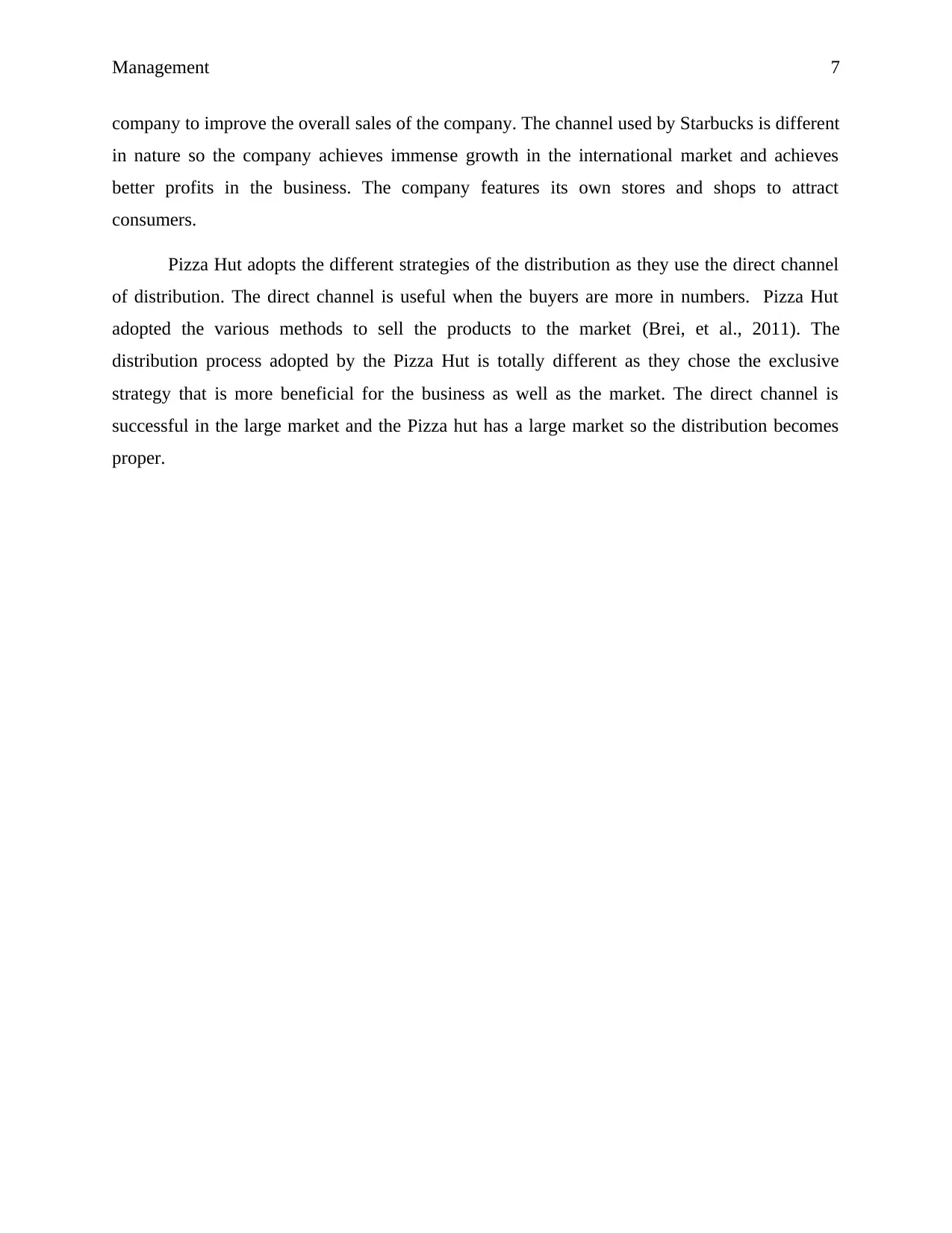
Management 7
company to improve the overall sales of the company. The channel used by Starbucks is different
in nature so the company achieves immense growth in the international market and achieves
better profits in the business. The company features its own stores and shops to attract
consumers.
Pizza Hut adopts the different strategies of the distribution as they use the direct channel
of distribution. The direct channel is useful when the buyers are more in numbers. Pizza Hut
adopted the various methods to sell the products to the market (Brei, et al., 2011). The
distribution process adopted by the Pizza Hut is totally different as they chose the exclusive
strategy that is more beneficial for the business as well as the market. The direct channel is
successful in the large market and the Pizza hut has a large market so the distribution becomes
proper.
company to improve the overall sales of the company. The channel used by Starbucks is different
in nature so the company achieves immense growth in the international market and achieves
better profits in the business. The company features its own stores and shops to attract
consumers.
Pizza Hut adopts the different strategies of the distribution as they use the direct channel
of distribution. The direct channel is useful when the buyers are more in numbers. Pizza Hut
adopted the various methods to sell the products to the market (Brei, et al., 2011). The
distribution process adopted by the Pizza Hut is totally different as they chose the exclusive
strategy that is more beneficial for the business as well as the market. The direct channel is
successful in the large market and the Pizza hut has a large market so the distribution becomes
proper.
Paraphrase This Document
Need a fresh take? Get an instant paraphrase of this document with our AI Paraphraser
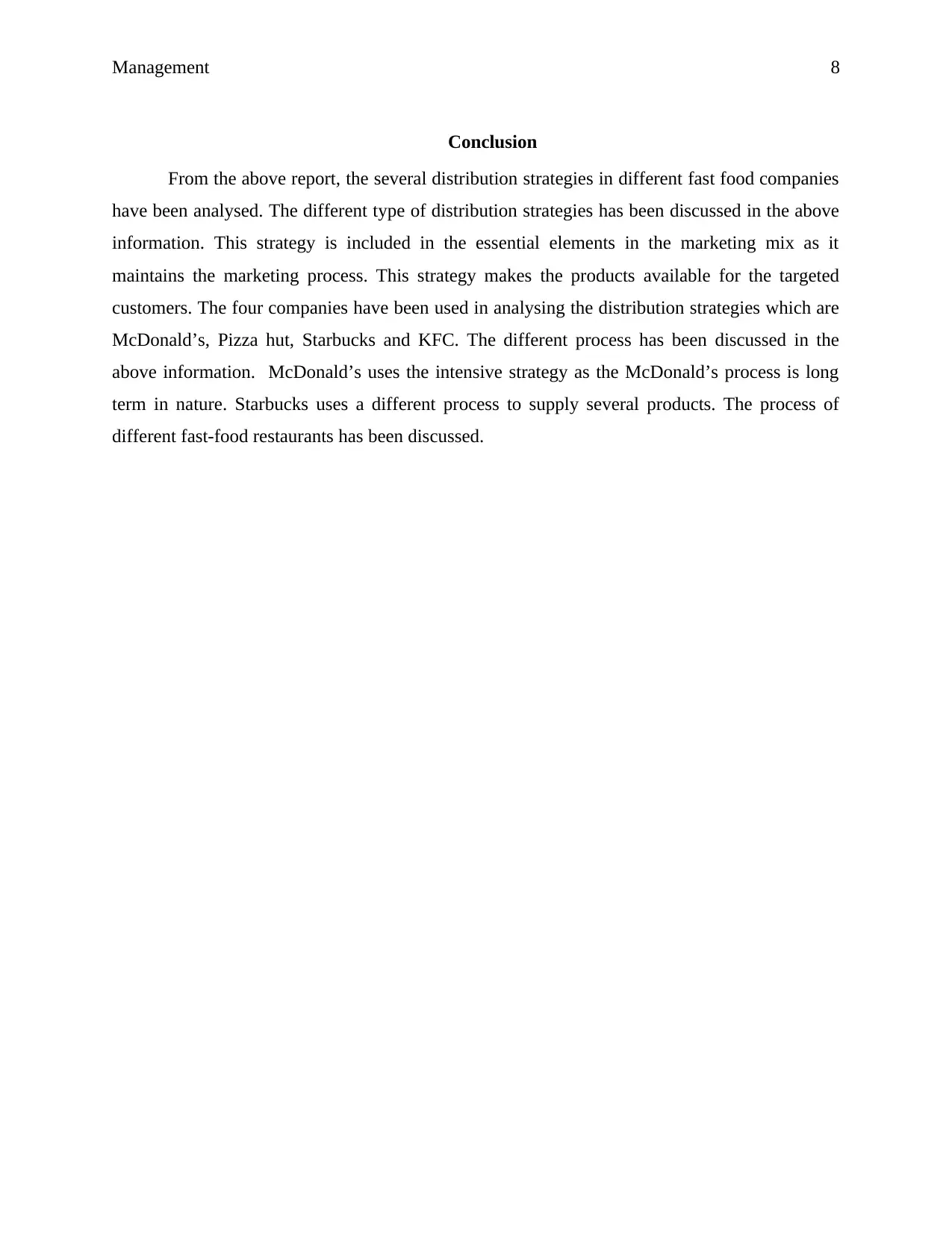
Management 8
Conclusion
From the above report, the several distribution strategies in different fast food companies
have been analysed. The different type of distribution strategies has been discussed in the above
information. This strategy is included in the essential elements in the marketing mix as it
maintains the marketing process. This strategy makes the products available for the targeted
customers. The four companies have been used in analysing the distribution strategies which are
McDonald’s, Pizza hut, Starbucks and KFC. The different process has been discussed in the
above information. McDonald’s uses the intensive strategy as the McDonald’s process is long
term in nature. Starbucks uses a different process to supply several products. The process of
different fast-food restaurants has been discussed.
Conclusion
From the above report, the several distribution strategies in different fast food companies
have been analysed. The different type of distribution strategies has been discussed in the above
information. This strategy is included in the essential elements in the marketing mix as it
maintains the marketing process. This strategy makes the products available for the targeted
customers. The four companies have been used in analysing the distribution strategies which are
McDonald’s, Pizza hut, Starbucks and KFC. The different process has been discussed in the
above information. McDonald’s uses the intensive strategy as the McDonald’s process is long
term in nature. Starbucks uses a different process to supply several products. The process of
different fast-food restaurants has been discussed.
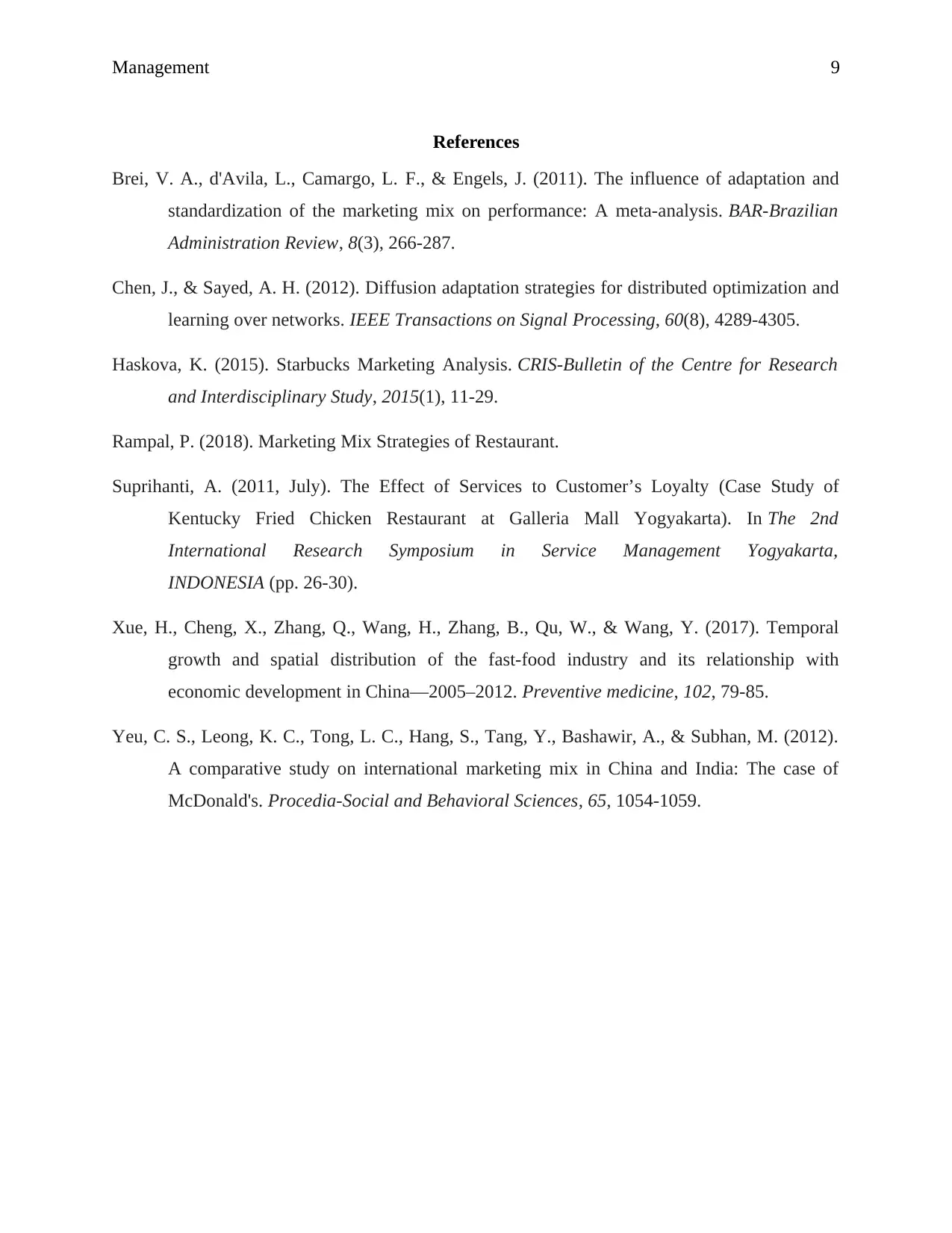
Management 9
References
Brei, V. A., d'Avila, L., Camargo, L. F., & Engels, J. (2011). The influence of adaptation and
standardization of the marketing mix on performance: A meta-analysis. BAR-Brazilian
Administration Review, 8(3), 266-287.
Chen, J., & Sayed, A. H. (2012). Diffusion adaptation strategies for distributed optimization and
learning over networks. IEEE Transactions on Signal Processing, 60(8), 4289-4305.
Haskova, K. (2015). Starbucks Marketing Analysis. CRIS-Bulletin of the Centre for Research
and Interdisciplinary Study, 2015(1), 11-29.
Rampal, P. (2018). Marketing Mix Strategies of Restaurant.
Suprihanti, A. (2011, July). The Effect of Services to Customer’s Loyalty (Case Study of
Kentucky Fried Chicken Restaurant at Galleria Mall Yogyakarta). In The 2nd
International Research Symposium in Service Management Yogyakarta,
INDONESIA (pp. 26-30).
Xue, H., Cheng, X., Zhang, Q., Wang, H., Zhang, B., Qu, W., & Wang, Y. (2017). Temporal
growth and spatial distribution of the fast-food industry and its relationship with
economic development in China—2005–2012. Preventive medicine, 102, 79-85.
Yeu, C. S., Leong, K. C., Tong, L. C., Hang, S., Tang, Y., Bashawir, A., & Subhan, M. (2012).
A comparative study on international marketing mix in China and India: The case of
McDonald's. Procedia-Social and Behavioral Sciences, 65, 1054-1059.
References
Brei, V. A., d'Avila, L., Camargo, L. F., & Engels, J. (2011). The influence of adaptation and
standardization of the marketing mix on performance: A meta-analysis. BAR-Brazilian
Administration Review, 8(3), 266-287.
Chen, J., & Sayed, A. H. (2012). Diffusion adaptation strategies for distributed optimization and
learning over networks. IEEE Transactions on Signal Processing, 60(8), 4289-4305.
Haskova, K. (2015). Starbucks Marketing Analysis. CRIS-Bulletin of the Centre for Research
and Interdisciplinary Study, 2015(1), 11-29.
Rampal, P. (2018). Marketing Mix Strategies of Restaurant.
Suprihanti, A. (2011, July). The Effect of Services to Customer’s Loyalty (Case Study of
Kentucky Fried Chicken Restaurant at Galleria Mall Yogyakarta). In The 2nd
International Research Symposium in Service Management Yogyakarta,
INDONESIA (pp. 26-30).
Xue, H., Cheng, X., Zhang, Q., Wang, H., Zhang, B., Qu, W., & Wang, Y. (2017). Temporal
growth and spatial distribution of the fast-food industry and its relationship with
economic development in China—2005–2012. Preventive medicine, 102, 79-85.
Yeu, C. S., Leong, K. C., Tong, L. C., Hang, S., Tang, Y., Bashawir, A., & Subhan, M. (2012).
A comparative study on international marketing mix in China and India: The case of
McDonald's. Procedia-Social and Behavioral Sciences, 65, 1054-1059.
⊘ This is a preview!⊘
Do you want full access?
Subscribe today to unlock all pages.

Trusted by 1+ million students worldwide
1 out of 9
Related Documents
Your All-in-One AI-Powered Toolkit for Academic Success.
+13062052269
info@desklib.com
Available 24*7 on WhatsApp / Email
![[object Object]](/_next/static/media/star-bottom.7253800d.svg)
Unlock your academic potential
Copyright © 2020–2025 A2Z Services. All Rights Reserved. Developed and managed by ZUCOL.





